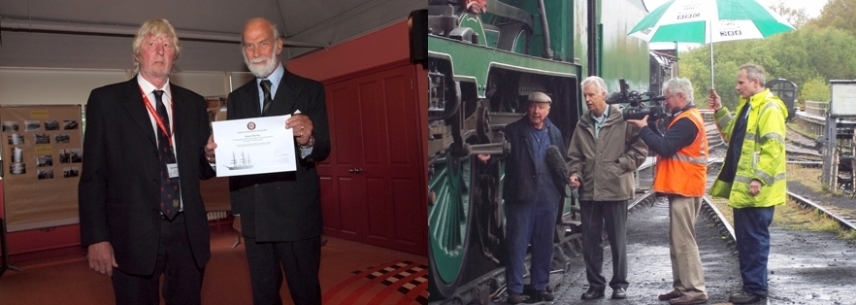The Trust offers financial assistance to individuals or groups to carry through restoration or improvement projects to completion. The Trust also invites enquiries about sponsoring one or more Awards.

Robert Morley:

A WWII motor torpedo boat caught Bob’s attention when he was a child and a seed was sown. Many years later he came across a Coastal Motor Boat, a WWI veteran 55ft long. It was sunk and derelict, but CMB 331 is now restored and displayed and at the Coastal Forces Museum at Gosport.
Next came Motor Launch 293, even bigger at 112ft in length, built in 1940 for the Royal Navy, brought back to first class condition over a 5 year restoration.
Boat number three was an RAF launch, number 2748, built in 1953 for target towing. When he first saw her she was sitting on the bottom in Barry and was in a very sorry state. Another one saved, now living in Plymouth.
The last in the line is Coastal Motor Boat 9, one of twelve 40ft vessels ordered by the Admiralty in 1916 and built by Thornycroft on the Thames at Hampton.
After action in WWI which included the sinking of a German destroyer in 1917, CMB9 was adapted to take part in a series of top secret experiments designed to test whether unmanned fast patrol boats armed with torpedoes could be controlled from the air and directed towards enemy targets. CMB9 was re-designated DCB1 - Distance Control Boat.
Distant Control Boats were never used operationally during the First World War, but their development continued for many years afterwards.d out, with an aeroplane controlling the boat by wireless from a height of 16,000 feet and a distance of 5 miles. Tests had shown that the height and distance from which the boat could be controlled were only limited by the visibility. Satisfactory runs had also been carried out by moonlight. During 1918 satisfactory runs were carried out, with an aeroplane controlling the boat by wireless from a height of 16,000 feet and a distance of 5 miles. Tests had shown that the height and distance from which the boat could be controlled were only limited by the visibility. Satisfactory runs had also been carried out by moonlight.
It appears that DCB1 returned to her former role as a Coastal Motor Boat once the trials were completed. As CMB9 she remained in service with the Royal Navy until the early 1950s. It seems that she carried out the routine duties of a Coastal Motor Boat during the Second World War.
Restoration of CMB9 has taken 6 years, and she is regularly on public display at events such as the Thames Traditional Boat Festival, which involves her in a journey past the yard in which she was built.

Bob is a Marine Surveyor and historic vessel consultant, which may make his hobby of restoring elderly boats seem like a busman’s holiday, but his record of saving these important vessels is exceptional and he is a worthy recipient of this award.
Ray Bellingham
Ray Bellingham has been Chairman and Chief Mechanical Engineer for the Maunsell Locomotive Society since the early 1970’s. He has overseen the restoration of 4 ex-Barry scrapyard locomotives in that time (U class 1618 and 1638, Q class 541 and S 15 847). In addition he oversaw the subsequent major overhaul of 847 concluded in 2013 and is leading the current heavy overhaul of Schools class Stowe.
This involves the most extensive boiler overhaul ever tackled at the Bluebell Railway. His involvement with U1618, his first ex-Barry loco, goes back well over 40 years. Ray is nearer 90 than 80, and yet he is in remarkably good health, and works three days a week for the Society. He has built up a small and loyal team of workers to assist on the projects and developed a mutually beneficial working arrangement with the Bluebell Railway which has also provided significant input into these projects. In the last ten years, under Ray’s leadership, over £300,000 has been raised by the Society and spent on locomotive overhauls and restoration.
Unfortunately circumstances conspired to prevent him receiving the award in person.
The National Transport Trust makes loans to groups, associations and individuals at advantageous rates for the restoration of artefacts - whether mobile or part of the infrastructure. Applications must be supported by a simple business plan which demonstrates the financial viability of the project. A sample business plan is available on request from the Treasurer.
The Trust does occasionaly make Awards for schemes which further the preservation movement. Again if you wish further information please contact the Treasurer.